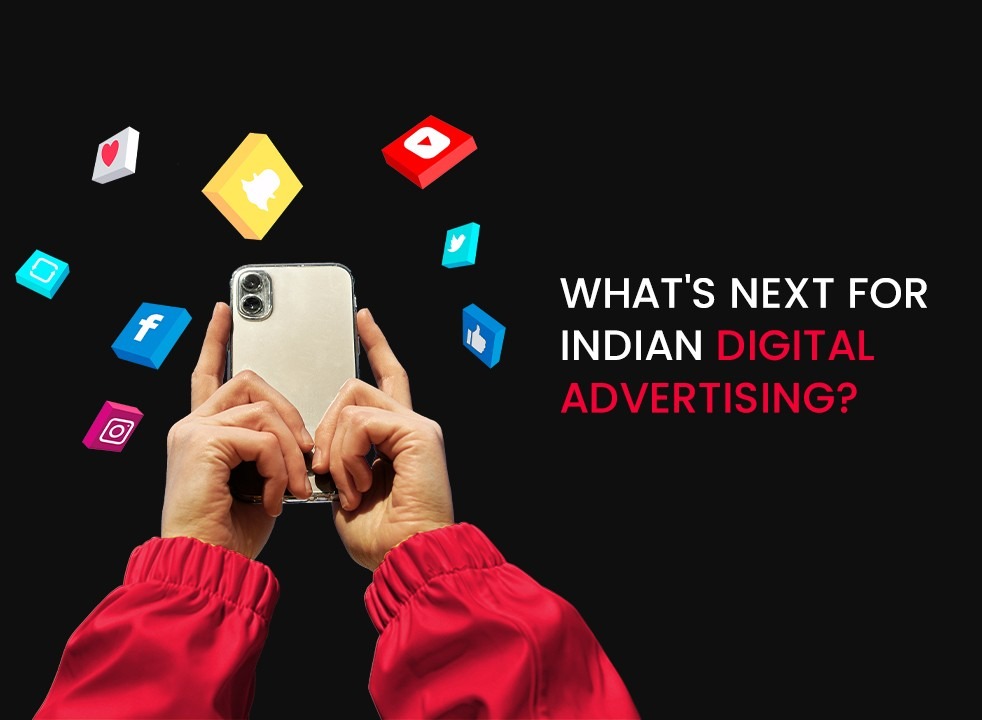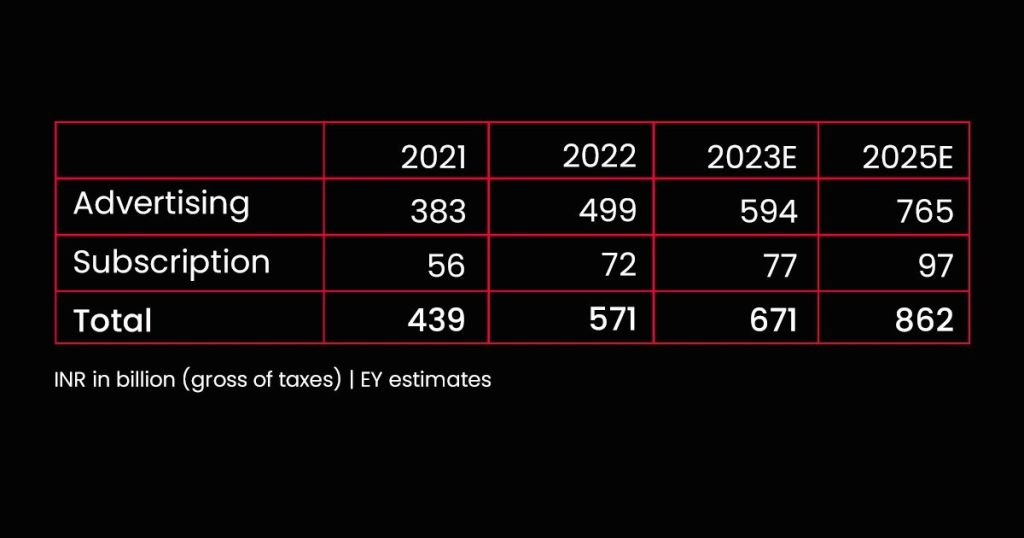What’s Next for Indian Digital Advertising?

“India is, the cradle of the human race, the birthplace of human speech, mother of history, the grandmother of legend, & great grandmother of tradition. our most valuable & most instructive materials in the history of man are treasured up in India only.”
- Mark Twain
In the ever-evolving landscape of digital advertising, India is poised to witness significant advancements and opportunities. With a rapidly growing digitized population and increasing connectivity, the future of Indian digital advertising is set to unfold in a multi-media-multi-window era. We have derived insights into the emerging trends and strategies from EY’s report on the Media & Entertainment industry that can be leveraged to navigate this transformative landscape.

Growth will be led by many different themes:
Several growth themes and opportunities, as mentioned below, will shape the future of Indian digital advertising.
Acceleration of Digital Media Consumption in ‘Bharat’:
Digital media consumption is witnessing accelerated growth in non-metro areas (‘Bharat’). With the focus on tapping into this emerging market by creating vernacular content, localizing messaging, and leveraging influencers who resonate with these audiences.
Influencer Marketing and Transaction-Driven Models:
Influencer marketing will continue to be a powerful tool for brands to reach out to their target audience directly. Additionally, transaction-driven models, such as affiliate marketing, will gain traction as more performance-driven approaches are taken to reach the goals.
More E-commerce Options:
India’s e-commerce landscape is expanding rapidly, creating new avenues. Brands should explore collaborations with e-commerce platforms, leverage sponsored product listings, and optimize their strategies for seamless integration into the e-commerce customer journey.
SME Ad Spends:
India’s SMEs contribute to just 30% of India’s GDP today compared to 40% in other emerging economies. And small and medium enterprises (SMEs) are increasingly recognizing the importance of digital advertising. This increases the scope further by catering to the specific needs of SMEs, offering cost-effective solutions, simplifying ad management platforms, and measurable ROI to encourage their continued investment in digital advertising.
Generative AI search:
Although still in its early stages, it holds immense potential to revolutionize the advertising landscape. This technology offers a range of benefits, including increased efficiency, productivity, cost reduction, and new revenue opportunities. As generative AI evolves, we foresee captivating applications in the advertising realm. For instance, it can enhance contextual advertising and in-content native advertising by optimizing content for generating search queries. Additionally, it can introduce modern commercial ad models across various search engines through paid content partnerships. Moreover, generative AI workflows can empower creators, and producers to generate, edit, and customize content advertising at scale, streamlining the creative process.
Personalized messaging:
Personalized messaging has become a critical aspect of digital advertising in India. This is driven by factors such as growing internet penetration across various socioeconomic classes (SECs) and cultural segments, the rise of e-commerce, a mobile-first market, and the presence of large online communities. Brands are leveraging big data and analytics solutions to gain deep insights into consumer behaviour and preferences, both at an individual level for their direct-to-consumer (D2C) audiences and by identifying hidden patterns to target other audience cohorts. This trend is expected to continue growing, leading to an increasing emphasis on personalized digital advertising in India.
Innovative digital interventions will drive the growth
Further, innovating digital interventions and adopting them across the consumer lifecycle can drive effective business outcomes. These unique digital interventions, as discussed below, will optimize the consumer journey and drive positive results.
Hyper-localized Targeted Campaigns:
As digital advertising becomes more sophisticated, region and city-level targeted campaigns take centre stage. Leveraging location-based data to deliver personalized messages to users in specific geographical areas increases consumer engagement on a hyper-local level. By tailoring content to local preferences and needs, brands can establish stronger connections and drive higher engagement.
Programmatic & Geo-Targeted Out of Home (OOH):
The integration of programmatic advertising with out-of-home (OOH) advertising presents a significant opportunity. By leveraging data-driven insights, it is easier to deliver contextually relevant messages to audiences in specific physical locations. This combination of programmatic and geo-targeting capabilities ensures that OOH ads are more effective and reach the right people at the right time.
Campaigns to Accelerate Contextual Purchases:
To capitalize on the growing e-commerce ecosystem, the focus is more on campaigns that accelerate purchases by providing opportunities to buy anything, anytime, anywhere with the click of a button. Deliver personalized recommendations and offers, creating a seamless path from ad exposure to purchase by leveraging real-time data and user behaviour insights. This approach enables brands to tap into the increasing trend of impulse buying and drive higher conversion rates.
One-to-One Marketing for Direct-to-Consumer Brands:
Direct-to-consumer (D2C) brands are gaining prominence in the Indian market, and one-to-one marketing will be the key to their success. By leveraging customer data and advanced segmentation techniques, D2C brands can deliver personalized experiences and tailored messaging to their target audiences. This approach fosters brand loyalty and strengthens customer relationships in a highly competitive landscape.
Behaviour-Enriched Cohorts in a Connected Commerce Ecosystem:
As the Indian digital landscape becomes more interconnected, the focus is on behaviour-enriched cohorts. It is now possible to create comprehensive customer profiles that enable precise targeting and messaging by analyzing user behaviour across multiple touchpoints. This approach ensures ads are delivered to the right audiences with higher conversion rates.
Key Channels of Digital Spending:
The allocation of ad spending across various digital channels will play a crucial role in shaping Indian digital advertising’s future. The key channels include social media, online video, and paid search.
Social media:
Social media will continue to be the dominant channel for digital advertising. With a user base of 470 million and daily usage of nearly three hours, social media offers immense reach and engagement opportunities. Leveraging the popularity of social media platforms, connect with the target audience effectively.
Online video:
The popularity of online video consumption is skyrocketing, presenting a significant opportunity to increase reach. As users increasingly consume video content across platforms, brands can leverage pre-roll, mid-roll, and native video ads to capture attention and deliver engaging brand messages.
Paid search:
Paid search advertising, driven by search engine marketing (SEM), remains an essential channel. By leveraging search intent and targeting relevant keywords, brands can ensure their ads appear prominently in search engine results, increasing visibility and driving targeted traffic.
Conclusion:
The future of Indian digital advertising is promising, with immense growth opportunities across multiple channels and themes. Tapping into the expanding digital landscape is imperative as the growth is skewed towards digital media & it will comprise 54% of total advertising by 2025. As the industry evolves, staying ahead of emerging trends and focusing on digital marketing will be crucial for brands to thrive in the competitive Indian market.
